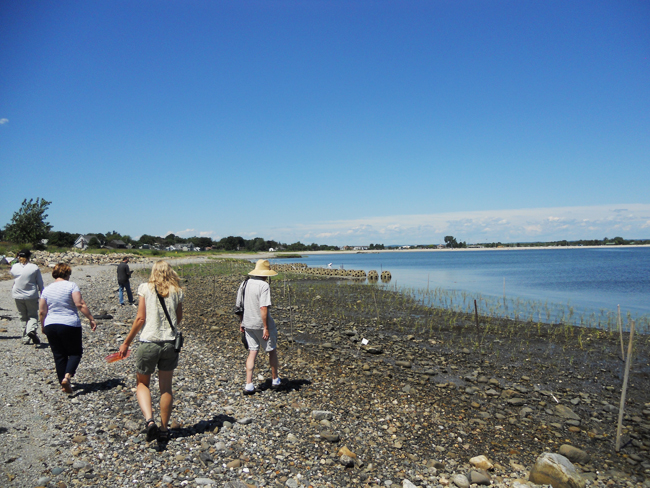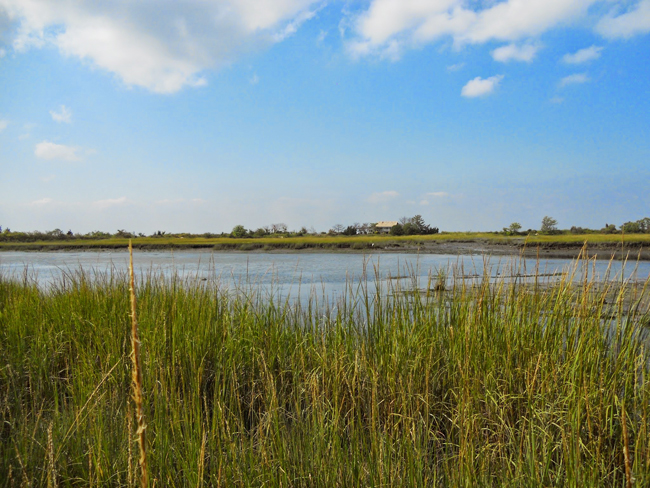
Along Long Island Sound's shoreline in Stratford Point, CT. Photo: Amy Mandelbaum, NYSG/LISS
Contacts:
Robert Burg, Long Island Sound Study, P: 203-977-1546, E: rburg@longislandsoundstudy.net
Barbara Branca, New York Sea Grant, P: 631-632-6956, E: barbara.branca@stonybrook.edu
Peg VanPatten, Connecticut Sea Grant, P: 860-405-9128, E: peg.vanpatten@uconn.edu
STONY BROOK, NY, April 11, 2017 - The Sea Grant programs of Connecticut (CTSG) and New York (NYSG) have awarded more than $676,000 in Long Island Sound Study (LISS) research grants to three projects that will look into some of the most serious threats to the ecological health of Long Island Sound, a water body designated by the Environmental Protection Agency as an Estuary of National Significance. The LISS, conducted under the EPA’s National Estuary Program, is a cooperative effort between the EPA and the states of Connecticut and New York to restore and protect the Sound and its ecosystems.This suite of projects addresses the cycling of nitrogen, phosphorus, and carbon through the Sound and its surrounding tributaries and wetlands.
Title: How will sea level rise-driven shifts in wetland vegetation alter ecosystem services?
University of Connecticut: Beth Lawrence, Ashley Helton, Chris Elphick
Total: $317,828 plus $79,458 in matching funds
Coastal marshes that fringe Long Island Sound are the dynamic ecosystems between land and sea that provide essential “ecosystem services” to surrounding communities such as improved water quality, carbon removal to the sediment, and protection from storm surge. However, as these valuable wetlands are increasingly altered by rising seas, invasive species and increased salinity, there are changes in carbon and nitrogen cycling as well as in plant species composition. Research conducted by Beth Lawrence and her team at the University of Connecticut will increase our understanding and improve coastal management by explicitly quantifying the direct and indirect effects of sea level rise on carbon and nitrogen cycling. The results will be extended to a broad audience by developing a series of questions and problems for high school students that integrates a case study of how sea level rise is altering coastal ecosystems associated with Long Island Sound.
Title: Nutrient and Carbon Fluxes through Long Island Sound, Linking River Sources to Impacted Areas
The University of Connecticut: Michael Whitney and Penny Vlahos
Total: $278,851
In Long Island Sound, the quality of its waters and health of its biological communities are strongly influenced by the concentration and movement of nutrients like nitrogen and phosphorus in the water. Both nitrogen and phosphorus, as well as carbon enter the Sound through rivers and are consumed and transformed along the way. University of Connecticut marine scientists Michael Whitney and Penny Vlahos will study sources, movement, and fates of these materials, as well as their flow from wastewater treatment plants, to understand the input from river sources and impacted areas. This will help determine the nature of sources and whether certain locations can store carbon. The results will inform management decisions for the Sound.
Title: Sources and fluxes of excess nitrogen supplied by fresh submarine groundwater discharge (FSGD) to Long Island Sound (LIS)
Stony Brook University: Troy Rasbury, Kirk Cochrane and Henry Bokuniewicz
Total: $119,776 plus $39,775 in matching funds
Fresh submarine groundwater discharge along Long Island’s north shore is an important source of nitrogen loading into the Sound. In some locations this discharge supplies as much nitrogen to bays as a local river and about 10 to 40 times as much as a local wastewater treatment plant. However, identifying whether the nitrogen source is natural or from a synthetic source (such as fertilizer) is difficult. Researchers from Stony Brook University will use a unique combination of isotope tracers to fingerprint the sources of nitrogen to groundwater as well as processes that affect nitrogen concentrations. The team will be able to quantify atmospheric, septic, animal waste, and fertilizer sources of new nitrogen entering the Sound via groundwater discharge in three “hot spots” with varying land use: a residential area/ golf course, a park near a sewage treatment plant, and an agricultural area. Such source information is critical in developing management strategies to reduce nitrogen loadings.

Long Island Sound's western basin is just north of Frost Creek in Lattingtown, NY. Photo: Amy Mandelbaum, NYSG/LISS
“These three projects will increase our understanding of Long Island Sound and directly support wise protection and restoration of its valuable resources” said Mark Tedesco, director of the U.S. EPA Long Island Sound Office, which manages the Long Island Sound Study partnership, and which provided the majority of funds for the Sea Grant-administered research projects. Since 2000, the Long Island Sound grant program has awarded more than 30 grants to scientists whose work helps meet the needs of decision-makers to improve the management of Long Island Sound.
"With these awards, the Connecticut and New York Sea Grant programs continue their partnership with EPA and universities in the region to document and better understand how Long Island Sound works, and how its workings will likely to be affected by a variety of factors, from attempts to reduce human nutrient inputs to the Sound to rising sea levels,” said Bill Wise, director of the New York Sea Grant Program.
“It is exciting to see different researchers using complementary approaches that, together, lead to an overall better understanding of the sources and sinks of nutrients. There is a lot of creativity in the academic communities that can contribute to a healthy Long Island Sound.” said Sylvain De Guise, director of the Connecticut Sea Grant program.
A portion of the research funding comes from the two Sea Grant programs. Connecticut Sea Grant, based at the University of Connecticut at Avery Point, and New York Sea Grant, based at Stony Brook University (SUNY), belong to the National Sea Grant College Program network, part of the National Oceanic and Atmospheric Administration.
For more on these and other Long Island Sound research ane outreach projects, visit www.longislandsoundstudy.net or www.nyseagrant.org/lisound.
More Info: Long Island Sound Study
Long Island Sound is one of the 28 nationally-designated estuaries under
the NEP, which was established by Congress in 1987 to improve the
quality of Long Island Sound and other places where rivers meet the sea.
The Long Island Sound Study, conducted under the Environmental
Protection Agency’s (EPA) National Estuary Program (NEP), is a
cooperative effort between the EPA and the states of Connecticut and New
York to restore and protect the Sound and its ecosystems.
For more on what you can do to make a difference, click over to the "Get Involved" or "Stewardship" sections of the Long Island Sound Study's Web site. News on the Long Island Sound Study can also be found in New York Sea Grant's related archives.
If you would like to receive Long Island Sound Study's newsletter, please visit their site's homepage and sign up for the "e-news/print newsletter" under the "Stay Connected" box.
For daily updates and tips on how you can help protect and restore Long Island Sound, please join LISS on Facebook, Twitter or, sign up for their RSS feeds.
More Info: New York Sea Grant
New York Sea Grant (NYSG), a cooperative program of Cornell University
and the State University of New York, is one of 33 university-based
programs under the National Sea Grant College Program (NSGCP) of the
National Oceanic and Atmospheric Administration (NOAA). The NSGCP
engages this network of the nation’s top universities in conducting
scientific research, education, training and extension projects designed
to foster science-based decisions about the use and conservation of our
aquatic resources. Through its statewide network of integrated
services, NYSG has been promoting coastal vitality, environmental
sustainability, and citizen awareness about the State’s marine and Great
Lakes resources since 1971.
New York Sea Grant maintains Great Lakes offices at SUNY Buffalo, the
Wayne County Cooperative Extension office in Newark and at SUNY Oswego.
In the State's marine waters, NYSG has offices at Stony Brook University
and Stony Brook Manhattan, in the Hudson Valley through Cooperative
Extension in Kingston and at Brooklyn College.
For updates on Sea Grant activities: www.nyseagrant.org has RSS, Facebook, Twitter, and YouTube links. NYSG produces a monthly e-newsletter, "NOAA Sea Grant's Social Media Review," via its blog, www.nyseagrant.org/blog. Our program also offers a free e-list sign up via www.nyseagrant.org/coastlines for its flagship publication, NY Coastlines/Currents, which is published 1-2 times a year.